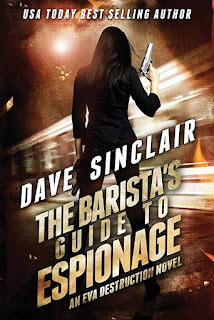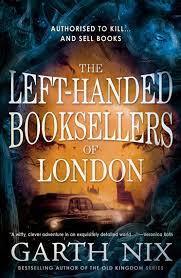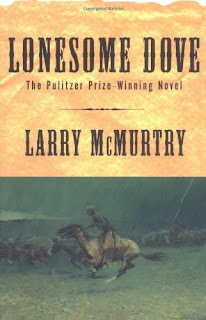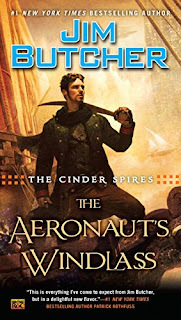Books I Read in May (Part 1)
With this post, I'm moving my weekly post to Wednesdays for no particular reason except to brighten your hump day.
Having read, or at least sampled, nine books in May so far, and with more than 3,000 words to say about them, I'm going to divide my reviews for May into two posts, starting with these first four books. Stay turned for my reviews of Hackly Hammet's Payment on Delivery, Gavin Chappell's On Hadrian's Secret Service, Richard Townshend Bickers' The Sands of Truth, Catherine Cole's Murder at the Manor, Malcolm Archibald's Windrush, and maybe more, coming in early June.

The Barista’s Guide to Espionage: An Eva Destruction Novelby Dave Sinclair C+
To described as amishmash of Stephanie Plum and James Bond would not be too far offthe mark. Ms Eva Destruction is more competent than Ms Plum, with amuch more action packed, James Bond movie style plot, but it hassomething of the humor of a Stephanie Plum novel. Though in the caseof Janet Evanovich’s novels, Ms Plum is the first person narrator,and thus she has a bit more character than Ms Destruction. The plot was too much over the top to take at all seriously. However, if youlike fast moving adventure stories with rich and powerful villains, lots of banter and innuendo, you should like this book very much. It alsoexplores the question of does the end justify the means, as well as love, andfeminism.
Interestinglyenough, Sinclair seems to set his books either in the near future or in analternate universe. Out of time began in 2024, and this one concernsthings like a Russian civil war, that do not, yet, exist. This beingthe second Dave Sinclair book I’ve read I can say that he’s agood writer. His books are just not quite my cup of tea, or I’dgrade them higher. Like Out of Time, this is a free book, the firstbook in his Eva Destruction series. I have one more of his free firstbooks, Kiss My Assassin, the first Charles Bishop book (who alsoappears in this book as well.) I liked Out of Time better, but Iexpect I will like the Charles Bishop book as well. We’ll see.

The Left HandedBooksellers of London by Garth Nix C-
Yes, yet anotherurban fantasy book set in London. I’m a sucker for books set inLondon. I believe that put a hold on this book at the library becauseof a mention by one of the booktubers I watch. It became available,so I put a pause on my “thriller” reading. It was... okay fora self-published book. You know, lots of alarms and excursions withnondescript, but not bad writing, and a hard to believe fantasypremise. This is, of course, a left handed compliment, if its acompliment at all, since this isn’t a self-published book. It isa traditionally published book that reads like a bog standardself-published book, fine in its way, but without any literaryaspirations. It doesn’t hold a candle to say, the gold standards ofLondon fantasy, like Neverwhere by Neil Gaiman or the Riversof London series by Ben Aaronovitch. While this book has plenty ofimagination, way too much, in fact, I found nothing in the writing orthe characters to be very engaging.
Briefly, thepremise, as far as I can tell, is that there are humans with variousmagical powers, i.e. the booksellers in the title, though there areboth right and left handed, as well as both handed booksellers whosejob is to keep an ancient magical menagerie – goblins, fairies, and other made up stuff, I think, in check, one way or another. Even though Iswear fully 2/3rds of this novel is an explanation of how everythingworks, it just seems tossed together. There doesn’t seem to be anysort of logic in the magic, despite all that explaining. Anything goes. The story features a young woman who comes to London to attenduniversity and to search for the father she never knew. She seems tohave ties to the fantasy realm via this unknown father. In thissearch, she quickly comes in contact with a sinister magical creatureand through it, the booksellers of the novel. Together with thebooksellers, who have their own reasons, she set out to search forher father and encounters magical events and beings in this quest.There is also a very lame romance thread in the story as well. Theaction moves along, between the long stretched of explanations andmusings...
The books suffersbadly from what I see as the great fault of fantasy; if you allowmagic in a story, the author can do anything they want, because, youknow, it’s magic. The author can get their characters into anysituation you can imagine, and get them out again just by pulling outa new magic trick out of their hat. As a reader, you just have to goalong with it.
This story had onemore annoying characteristic; it played the Ready Player Onegame of tossing in all sorts of factoids about this story’s timeperiod, 1983. I get annoyed when an author peppers the narrativewith random factoids likely gleaned from a search on wikipedia and whichstick out like sore thumbs because their inclusion seems to be an attempt to use them as "world-building,since they do not seem organic narrative of the moment. I complainedabout this in a Victorian mystery novel I read recently. In thiscase, the author would take time to name the best sellers in thebookshop window when they walked into the bookshop, or the music onBBC 1 during a car chase, or whatever. Out of Time did thisfor 1963, but at least in that book the narrator was from 2024, sothat his noting of the differences made sense within the story.
So to sum this bookup, if you like urban fantasy, I suppose it is fine. I found it, atfirst, as I said, okay, but as it went on, the magical world seemed to be invented in the moment and the story a series of random magicalincidents, interspersed with lots of explanations, all of which did notactually tie the magical world together, with the bonus annoyance of a shower of factoids about 1983 London.

Lonesome Doveby Larry McMurtry DNF 90% (½ way through Part 3)
I must confess thatafter reading the first two books in this sagas, Dead Man Walk andComanche Moon, I was not looking forward to reading theoriginal book in the saga. I had, however, a little hope that itwould be something a bit different. Indeed at the start I was hopefulthat it might turn out to be an entertaining book, more to my taste.But alas, that was not the case. It soon became just like the firsttwo books; an overly long book consisting of a main plot linesupplemented by sketches and vignettes of variousintelligence-challenged characters who do foolish and stupid things over and over again until they meet their sticky endings.
McMurtry’s writingstyle is to assemble a cast of dim witted characters and then hopfrom head to head between them, filling multiple pages withdescriptions of their mundane thoughts. These are descriptions of their thoughts, mind you,not any actual internal dialog, and thus, they all read pretty much alike.This descriptive of thoughts can run on and on for pages just to tell thereader that the character is scared, or cold, confused, just wants toget away... ad infinitum. And yet, despite these extendeddescriptions, the reader is often left without any clear idea whythese characters do the foolish things that the do that eventually gets themdead. And this sketchiness extends to the main characters’ thoughtsand motivations as well. Why go to Wyoming? A whim? People getting killed on the whim of their employer,,, Not much to be admired about.
In addition to all the dim-witted people,McMurtry also takes you into the minds of a variety of very cruel andviolent people who graphically abuse, rape, torture, and murderpeople, including the dim witted ones we sort of get to know.Essentially McMurtry writes “grimdark westerns”. After readingthese books, one is left with the idea that the Texas of the lasthalf of the 1800’s was entirely populated with dumb people andvicious murderers, sheep and wolves. It seems that some things never…oh, never mind.
I fond a great dealof tedium, unpleasantness, and little joy in reading this book. As Iwent along, I found that I began to skim and skip tedious sections ofboring thoughts as well as scenes of graphic violence in a hurry tofinish this book. I spent $5 on it, after all, and it wassupposed to be a masterpiece. In the end, however, I reached thepoint in the book, about ½ way through the Part 3 of the book whereMcMurtry kills off the likable character inthe book, except the pigs, and so I had no one to care about anymore and called it a day. Despite the praise this book gets, it isclearly not my type of story, which after reading the first two booksin the saga, came as no great surprise, though, as I said, I hadhopes... I won’t be reading the last book in the saga, which soundslike just more of the same. If I ever get the urge to read a western again, I’llstick to Zane Grey.

The Aeronaut’sWindless by Jim Butcher B
This was a goodadventure story set in a vast city tower, one of many – each one anation. The surface of the earth is apparently wilderness and hauntedby something. I guess. I had expected a more nautical adventure, whatwith the title and cover illustration, but 4/5th of thestory takes place within the tower city. I have no great complaints,save for the fact that I get quickly bored by battles and fightscenes, of which there are a number of in the story. Most peoplelike them, so that should be a selling point for many. At least theydid not run on for two chapters like the barroom brawl Brandon Sanderson had in his The Alloy of Law that I read and reviewed last fall. This is the first book of theseries, but the second has been long delayed, though I gather that itmight be released late this year. I will read it when it becomesavailable. I am sure Mr. Butcher will be overjoyed to hear that.



